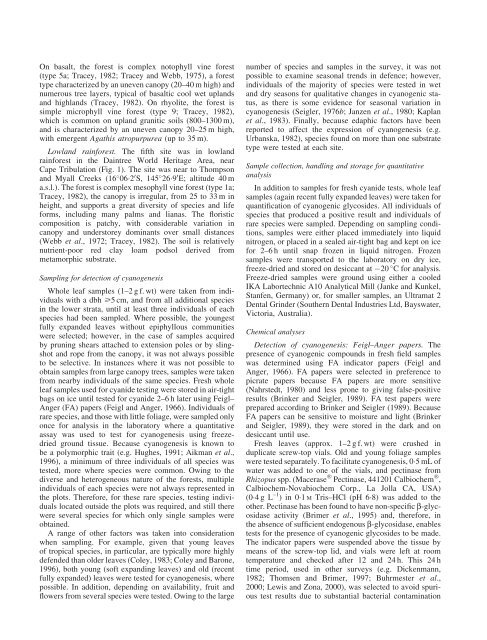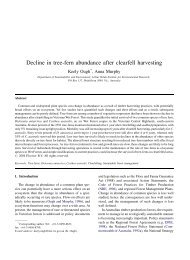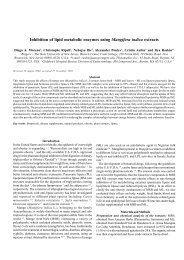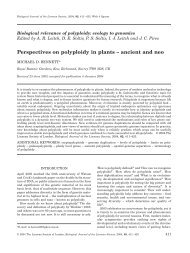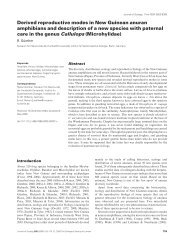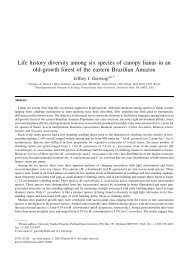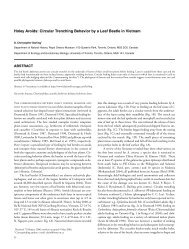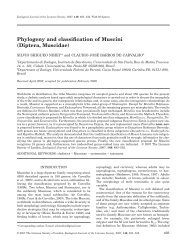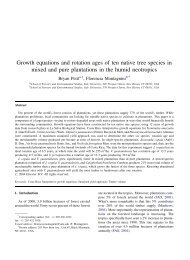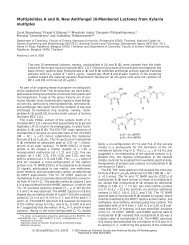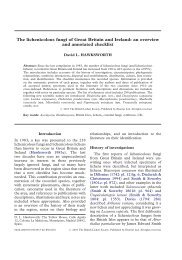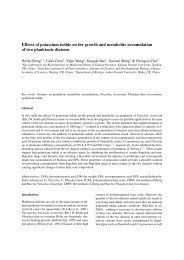Frequency of Cyanogenesis in Tropical Rainforests of Far North ...
Frequency of Cyanogenesis in Tropical Rainforests of Far North ...
Frequency of Cyanogenesis in Tropical Rainforests of Far North ...
Create successful ePaper yourself
Turn your PDF publications into a flip-book with our unique Google optimized e-Paper software.
On basalt, the forest is complex notophyll v<strong>in</strong>e forest<br />
(type 5a; Tracey, 1982; Tracey and Webb, 1975), a forest<br />
type characterized by an uneven canopy (20–40 m high) and<br />
numerous tree layers, typical <strong>of</strong> basaltic cool wet uplands<br />
and highlands (Tracey, 1982). On rhyolite, the forest is<br />
simple microphyll v<strong>in</strong>e forest (type 9; Tracey, 1982),<br />
which is common on upland granitic soils (800–1300 m),<br />
and is characterized by an uneven canopy 20–25 m high,<br />
with emergent Agathis atropurpurea (up to 35 m).<br />
Lowland ra<strong>in</strong>forest. The fifth site was <strong>in</strong> lowland<br />
ra<strong>in</strong>forest <strong>in</strong> the Da<strong>in</strong>tree World Heritage Area, near<br />
Cape Tribulation (Fig. 1). The site was near to Thompson<br />
and Myall Creeks (16 062 0 S, 145 269 0 E; altitude 40 m<br />
a.s.l.). The forest is complex mesophyll v<strong>in</strong>e forest (type 1a;<br />
Tracey, 1982), the canopy is irregular, from 25 to 33 m <strong>in</strong><br />
height, and supports a great diversity <strong>of</strong> species and life<br />
forms, <strong>in</strong>clud<strong>in</strong>g many palms and lianas. The floristic<br />
composition is patchy, with considerable variation <strong>in</strong><br />
canopy and understorey dom<strong>in</strong>ants over small distances<br />
(Webb et al., 1972; Tracey, 1982). The soil is relatively<br />
nutrient-poor red clay loam podsol derived from<br />
metamorphic substrate.<br />
Sampl<strong>in</strong>g for detection <strong>of</strong> cyanogenesis<br />
Whole leaf samples (1–2 g f. wt) were taken from <strong>in</strong>dividuals<br />
with a dbh >5 cm, and from all additional species<br />
<strong>in</strong> the lower strata, until at least three <strong>in</strong>dividuals <strong>of</strong> each<br />
species had been sampled. Where possible, the youngest<br />
fully expanded leaves without epiphyllous communities<br />
were selected; however, <strong>in</strong> the case <strong>of</strong> samples acquired<br />
by prun<strong>in</strong>g shears attached to extension poles or by sl<strong>in</strong>gshot<br />
and rope from the canopy, it was not always possible<br />
to be selective. In <strong>in</strong>stances where it was not possible to<br />
obta<strong>in</strong> samples from large canopy trees, samples were taken<br />
from nearby <strong>in</strong>dividuals <strong>of</strong> the same species. Fresh whole<br />
leaf samples used for cyanide test<strong>in</strong>g were stored <strong>in</strong> air-tight<br />
bags on ice until tested for cyanide 2–6 h later us<strong>in</strong>g Feigl–<br />
Anger (FA) papers (Feigl and Anger, 1966). Individuals <strong>of</strong><br />
rare species, and those with little foliage, were sampled only<br />
once for analysis <strong>in</strong> the laboratory where a quantitative<br />
assay was used to test for cyanogenesis us<strong>in</strong>g freezedried<br />
ground tissue. Because cyanogenesis is known to<br />
be a polymorphic trait (e.g. Hughes, 1991; Aikman et al.,<br />
1996), a m<strong>in</strong>imum <strong>of</strong> three <strong>in</strong>dividuals <strong>of</strong> all species was<br />
tested, more where species were common. Ow<strong>in</strong>g to the<br />
diverse and heterogeneous nature <strong>of</strong> the forests, multiple<br />
<strong>in</strong>dividuals <strong>of</strong> each species were not always represented <strong>in</strong><br />
the plots. Therefore, for these rare species, test<strong>in</strong>g <strong>in</strong>dividuals<br />
located outside the plots was required, and still there<br />
were several species for which only s<strong>in</strong>gle samples were<br />
obta<strong>in</strong>ed.<br />
A range <strong>of</strong> other factors was taken <strong>in</strong>to consideration<br />
when sampl<strong>in</strong>g. For example, given that young leaves<br />
<strong>of</strong> tropical species, <strong>in</strong> particular, are typically more highly<br />
defended than older leaves (Coley, 1983; Coley and Barone,<br />
1996), both young (s<strong>of</strong>t expand<strong>in</strong>g leaves) and old (recent<br />
fully expanded) leaves were tested for cyanogenesis, where<br />
possible. In addition, depend<strong>in</strong>g on availability, fruit and<br />
flowers from several species were tested. Ow<strong>in</strong>g to the large<br />
number <strong>of</strong> species and samples <strong>in</strong> the survey, it was not<br />
possible to exam<strong>in</strong>e seasonal trends <strong>in</strong> defence; however,<br />
<strong>in</strong>dividuals <strong>of</strong> the majority <strong>of</strong> species were tested <strong>in</strong> wet<br />
and dry seasons for qualitative changes <strong>in</strong> cyanogenic status,<br />
as there is some evidence for seasonal variation <strong>in</strong><br />
cyanogenesis (Seigler, 1976b; Janzen et al., 1980; Kaplan<br />
et al., 1983). F<strong>in</strong>ally, because edaphic factors have been<br />
reported to affect the expression <strong>of</strong> cyanogenesis (e.g.<br />
Urbanska, 1982), species found on more than one substrate<br />
type were tested at each site.<br />
Sample collection, handl<strong>in</strong>g and storage for quantitative<br />
analysis<br />
In addition to samples for fresh cyanide tests, whole leaf<br />
samples (aga<strong>in</strong> recent fully expanded leaves) were taken for<br />
quantification <strong>of</strong> cyanogenic glycosides. All <strong>in</strong>dividuals <strong>of</strong><br />
species that produced a positive result and <strong>in</strong>dividuals <strong>of</strong><br />
rare species were sampled. Depend<strong>in</strong>g on sampl<strong>in</strong>g conditions,<br />
samples were either placed immediately <strong>in</strong>to liquid<br />
nitrogen, or placed <strong>in</strong> a sealed air-tight bag and kept on ice<br />
for 2–6 h until snap frozen <strong>in</strong> liquid nitrogen. Frozen<br />
samples were transported to the laboratory on dry ice,<br />
freeze-dried and stored on desiccant at 20 C for analysis.<br />
Freeze-dried samples were ground us<strong>in</strong>g either a cooled<br />
IKA Labortechnic A10 Analytical Mill (Janke and Kunkel,<br />
Stanfen, Germany) or, for smaller samples, an Ultramat 2<br />
Dental Gr<strong>in</strong>der (Southern Dental Industries Ltd, Bayswater,<br />
Victoria, Australia).<br />
Chemical analyses<br />
Detection <strong>of</strong> cyanogenesis: Feigl–Anger papers. The<br />
presence <strong>of</strong> cyanogenic compounds <strong>in</strong> fresh field samples<br />
was determ<strong>in</strong>ed us<strong>in</strong>g FA <strong>in</strong>dicator papers (Feigl and<br />
Anger, 1966). FA papers were selected <strong>in</strong> preference to<br />
picrate papers because FA papers are more sensitive<br />
(Nahrstedt, 1980) and less prone to giv<strong>in</strong>g false-positive<br />
results (Br<strong>in</strong>ker and Seigler, 1989). FA test papers were<br />
prepared accord<strong>in</strong>g to Br<strong>in</strong>ker and Seigler (1989). Because<br />
FA papers can be sensitive to moisture and light (Br<strong>in</strong>ker<br />
and Seigler, 1989), they were stored <strong>in</strong> the dark and on<br />
desiccant until use.<br />
Fresh leaves (approx. 1–2 g f. wt) were crushed <strong>in</strong><br />
duplicate screw-top vials. Old and young foliage samples<br />
were tested separately. To facilitate cyanogenesis, 05mL<strong>of</strong><br />
water was added to one <strong>of</strong> the vials, and pect<strong>in</strong>ase from<br />
Rhizopus spp. (Macerase Ò Pect<strong>in</strong>ase, 441201 Calbiochem Ò ,<br />
Calbiochem-Novabiochem Corp., La Jolla CA, USA)<br />
(04g L –1 )<strong>in</strong>01 M Tris–HCl (pH 68) was added to the<br />
other. Pect<strong>in</strong>ase has been found to have non-specific b-glycosidase<br />
activity (Brimer et al., 1995) and, therefore, <strong>in</strong><br />
the absence <strong>of</strong> sufficient endogenous b-glycosidase, enables<br />
tests for the presence <strong>of</strong> cyanogenic glycosides to be made.<br />
The <strong>in</strong>dicator papers were suspended above the tissue by<br />
means <strong>of</strong> the screw-top lid, and vials were left at room<br />
temperature and checked after 12 and 24 h. This 24 h<br />
time period, used <strong>in</strong> other surveys (e.g. Dickenmann,<br />
1982; Thomsen and Brimer, 1997; Buhrmester et al.,<br />
2000; Lewis and Zona, 2000), was selected to avoid spurious<br />
test results due to substantial bacterial contam<strong>in</strong>ation


